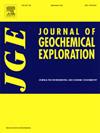Modeling mineralization potential of catchment basins: Insight from geochemical fingerprint
IF 3.4
2区 地球科学
Q1 GEOCHEMISTRY & GEOPHYSICS
引用次数: 0
Abstract
Stream sediments are common sampling media in cost-effective regional exploration programs. Catchment basins are the basic sampling units of steam sediments, which have distinct geochemical characteristics. In this study, the mineralization potential of catchment basin using stream sediments is evaluated from the perspective of geochemical fingerprints. Firstly, the spatial distribution of catchment basins was acquired based on digital elevation model data. The local singularity analysis was employed to reduce the impact of the overburden, revealing the weak geochemical anomalies. The catchment basins with known mineral occurrences as the prior dataset were used to train the random forest model, which improved the model accuracy and interpretability. The geochemical fingerprints of different types of mineralization were constructed based on the importance of geochemical variables in the random forest modeling, which revealed the importance of geochemical elements for different types of mineralization occurrences. All catchment basins lacking mineral occurrences were categorized based on the trained random forest model, achieving the potential types of mineralization for each catchment basin. Most of catchment basins with the same types of mineralization occurrences exhibited the spatial cluster, suggesting the migration characteristics of metal element in stream sediments through river system. Geochemical fingerprinting is a valuable tool for classifying the different types of mineralization occurrences at the scale of catchment basins. The delineated potential mineral occurrence types for catchment basins provided an indicator for future mineral exploration endeavors.
求助全文
约1分钟内获得全文
求助全文
来源期刊

Journal of Geochemical Exploration
地学-地球化学与地球物理
CiteScore
7.40
自引率
7.70%
发文量
148
审稿时长
8.1 months
期刊介绍:
Journal of Geochemical Exploration is mostly dedicated to publication of original studies in exploration and environmental geochemistry and related topics.
Contributions considered of prevalent interest for the journal include researches based on the application of innovative methods to:
define the genesis and the evolution of mineral deposits including transfer of elements in large-scale mineralized areas.
analyze complex systems at the boundaries between bio-geochemistry, metal transport and mineral accumulation.
evaluate effects of historical mining activities on the surface environment.
trace pollutant sources and define their fate and transport models in the near-surface and surface environments involving solid, fluid and aerial matrices.
assess and quantify natural and technogenic radioactivity in the environment.
determine geochemical anomalies and set baseline reference values using compositional data analysis, multivariate statistics and geo-spatial analysis.
assess the impacts of anthropogenic contamination on ecosystems and human health at local and regional scale to prioritize and classify risks through deterministic and stochastic approaches.
Papers dedicated to the presentation of newly developed methods in analytical geochemistry to be applied in the field or in laboratory are also within the topics of interest for the journal.
 求助内容:
求助内容: 应助结果提醒方式:
应助结果提醒方式:


